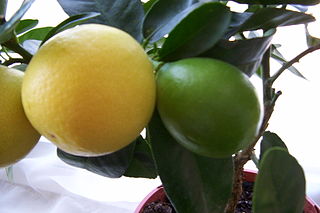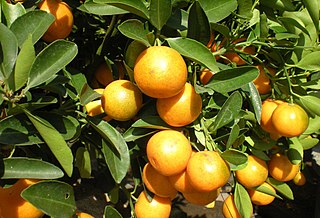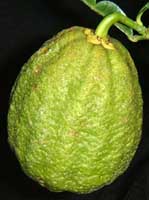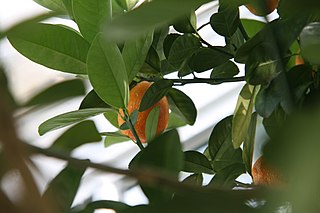
Kumquats, or cumquats in Australian English, are a group of small, angiosperm, fruit-bearing trees in the family Rutaceae. Their taxonomy is disputed. They were previously classified as forming the now-historical genus Fortunella or placed within Citrus, sensu lato. Different classifications have alternatively assigned them to anywhere from a single species, Citrus japonica, to numerous species representing each cultivar. Recent genomic analysis defines three pure species, Citrus hindsii, C. margarita and C. crassifolia, with C. × japonica being a hybrid of the last two.

Calamansi, also known as calamondin, Philippine lime, or Philippine lemon, is a citrus hybrid cultivated predominantly in the Philippines. It is native to the Philippines, parts of Indonesia, Malaysia, and Brunei, as well as parts of southern China and Taiwan.

Citrus unshiu is a semi-seedless and easy-peeling citrus species, also known as the satsuma mandarin or Japanese mandarin. During the Edo period of Japan, kishu mikans were more popular because there was a popular superstition that eating Citrus unshiu without seeds made people prone to infertility. Citrus unshiu became popular in Japan after modernization started in the Meiji period. It was introduced to the West from the Satsuma region of Japan in 1878.

The limequat is a citrus hybrid that is the result of a cross between the Key lime and the kumquat, hybridized by Walter Tennyson Swingle in 1909.

The mandarinquat, also misleadingly called orangequat, is any cross between a mandarin and a kumquat. Mandarinquats are members of the citrofortunella group.

Citrus japonica, the round kumquat, Marumi kumquat, or Morgani kumquat, is a species of citrus fruit in the genus Citrus. It was first described by Carl Peter Thunberg in 1780 as Fortunella japonica.

Papeda or papaeda is the common name for a group of Citrus species and varieties native to tropical Asia that are hardy and slow-growing, and produce unpalatable fruit. Walter Tennyson Swingle segregated these species into a separate subgenus, Papeda, that included the Ichang lemon, yuzu, kaffir lime, kabosu, sudachi, and a number of wild and uncultivated species and hybrids. Recent genetic analysis shows the papedas to be distributed among distinct branches of the Citrus phylogenetic tree, and hence Swingle's proposed subgenus is polyphyletic and not a valid taxonomic grouping, but the term persists as a common name.

Citrus crassifolia, the Meiwa kumquat, is a species of kumquat; a type of citrus fruit in the genus Citrus, family Rutaceae. It was first described by the American botanist Walter Tennyson Swingle in 1915 as Fortunella crassifolia.

Citrus macroptera, natively known as hatkhora or cabuyao, Melanesian papeda, or wild orange, is a semi-wild species of citrus native to the Sylhet region of Bangladesh and the Barak Valley Division of the Indian state of Assam.
Citrus halimii, or mountain citron, is a citrus with sour fruit. Historically placed within the polyphyletic grouping of papedas, it has since been determined to be a wild species most closely related to the kumquats, and is not related to the true citron. It was first discovered and catalogued in 1973.

Citrofortunella are a large group of commercial hybrids that cross the kumquat with other citrus. In the system of citrus taxonomy established by Swingle, kumquats were placed in a different genus, Fortunella, from Citrus, which included citron, mandarin orange, pomelo and papedas. The result of genetic crosses between kumquats and these other citrus would then be intergeneric hybrids, so a novel genus name was coined for them in 1975, by compounding the names of the contributing genera to form Citrofortunella. That the genus is of a hybrid nature is represented by a multiplication sign before the genus name, for example × Citrofortunella microcarpa. Recent phylogenetic work has shown kumquats to fall within Citrus rather than belonging to a distinct genus, meaning these would no longer be considered intergeneric hybrids, and use of Citrofortunella as a distinct genus name for these hybrids loses taxonomic validity. All would be placed instead within Citrus.

The citrangequat is a citrus hybrid of a citrange and a kumquat, developed by Walter Swingle at Eustis, Florida, in 1909. Citrangequats are bitter in taste, but are considered edible by some at the peak of their maturity. Three named cultivars exist:
Clymenia is a small genus of flowering plants in the family Rutaceae with two species. The genus is often included in Citrus.

Citrus taxonomy is the botanical classification of the species, varieties, cultivars, and graft hybrids within the genus Citrus and related genera, found in cultivation and in the wild.
Procimequat is a triploid citrus hybrid or transgeneric hybrid, x Fortunella hindsii, in which the limequat that itself is a cross between lime and a round kumquat, was backcrossed with the primitive Hong Kong kumquat.

The Murcott is a tangor, or mandarin–sweet orange hybrid.

Atalantia is a genus of flowering plants in the citrus family, the Rutaceae.

Citrus obovata, the Jiangsu kumquat or Fukushu kumquat, is a species of kumquat; a type of citrus fruit in the genus Citrus, family Rutaceae. It was first described by the French biologist Constantine Samuel Rafinesque in 1838.

Citrus margarita, the oval kumquat or Nagami kumquat, is a species of kumquat; a type of citrus fruit in the genus Citrus, family Rutaceae. Its epithet, margarita, is Latin for pearly.

Citrus swinglei, the Malayan kumquat, is a species of kumquat; a type of citrus fruit in the genus Citrus, family Rutaceae. It was first described by Burkill ex Harms in 1931.

















